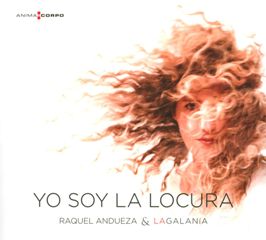Raquel Andueza - Yo Soy La Locura (2014)
Raquel Andueza - Yo Soy La Locura (2014)

1.Yo soy la locura 2.Marizápalos 3.No pienso Menguilla 4.Olvidada soys de mi 5.Folías 6.Ojos, pues me desdenais 7.Amor en estremos tales 8.Vuestra belleza señora 9.Sé que me muero 10.Españoletas 11.La ausençia 12.Vuestros ojos 13.O más que Venus 14.El baxel está en la playa 15.Solo es querer Raquel Andueza – soprano La Galania: Jesús Fernández Baena – tiorba Pierre Pitzl - baroque guitar
In the early 17th century a style emerged in Italy among the features of which were a close connection between text and music and the support of voices and instruments by a basso continuo. This style quickly disseminated across Europe but Spain was one of the countries where it had little influence. It was only in the latter decades of the century that Italian influence made itself felt. At least, according to an often held view. However, it needs some correction. The basso continuo practice made its appearance quite soon and so did the emphasis on the emotional aspects of musical performance. These features come to the fore in the genre of the tono humano, a song for one or several solo voices with accompaniment.
Especially in the second half of the 17th century this genre became very popular. Among the composers of such pieces are José Marín and Juan Hidalgo, both represented on the present disc. A large number of such songs are anonymous, and many of them were collected in the so-called Manuscrito Guerra. This collection is the subject of a series of discs by the Spanish ensemble Ars Antlantiqua for Naxos; so far three discs have been released (vol. 1: 8.570135; vol. 2: 8.572876; vol. 3: 8.573312).
It is interesting to note that some of the pieces on the present disc are from sources outside Spain. The reason is that in the early decades of the century Spanish culture in general and Spanish music in particular became quite popular in France and Italy. That explains why Gabriel Bataille included several pieces in the collections of songs which he published from 1609 to 1614. One of them is Ojos vuestros which was then included by Robert Dowland in his Musicall Banquet of 1610. It is one of the better-known songs, recorded also by Nigel Rogers as part of his disc devoted to Robert Dowland's collection (EMI, 1977; reissued 1991). Part of the French fascination with Spanish culture was due to the guitar, the chitarra espagnola. Even Louis XIII was attracted by the instrument and may have been taught to play it by the Spanish immigrant Luis de Briceño. This fascination for everything Spanish - mingled with a kind of disdain - is documented on a disc by Le Poème Harmonique (review). A late specimen of that is the inclusion of Sé que me muero in Le bourgeois gentilhomme, the famous comédie-ballet by Jean-Baptiste Lully, on a libretto by Molière.
The Spanish guitar was also embraced in Italy. Here the Spanish rule of Naples - until 1706 - was instrumental in the dissemination of Spanish music, including tonos humanos. Benedetto Sanseverino published a collection of songs that featured 18 pieces on a Spanish text with a guitar accompaniment in alfabeto notation. Raquel Andueza recorded so-called alfabeto songs on a disc with Pierre Pitzl's ensemble Private Musicke. A token of the popularity of such songs is the fact that a collection which was published by Giovanni Stefani was reprinted four times. The anonymous La ausença is taken from one of his editions.
All the songs are strophic; some include a refrain. They are about love, and mostly its various tribulations, sometimes driving the protagonists to a state of madness as the title piece suggests: "I am insanity, that which only instils pleasure and sweetness and happiness to the world." The emotional features of this kind of song are clearly inspired by the Italian seconda prattica but there is also a difference. Spanish composers avoided harmonic experiments focusing instead on the rhythmic expression of the text. That is emphasized through the use of plucked instruments for the accompaniment.
Raquel Andueza is like a fish in water in this repertoire. From the word go you feel that this is her core business. It helps that she is a native Spanish speaker. Performances by non-Spanish singers often suffer from a style of singing which they think is Spanish but is probably a product of fantasy. That goes especially for recordings from the 1970s and 1980s. Now that many Spanish artists take care of their own musical heritage we get a better impression of what is Spanish in early music. The fascination of this kind of music is not confined to the 17th century. In our time it has many admirers among music-lovers. They shouldn't miss this disc which delivers a highly compelling survey of the repertoire of Spanish tonos humanos. ---Johan van Veen, musicweb-international.com
download (mp3 @320 kbs):
yandex mediafire uloz.to mega 4shared cloudmailru gett








